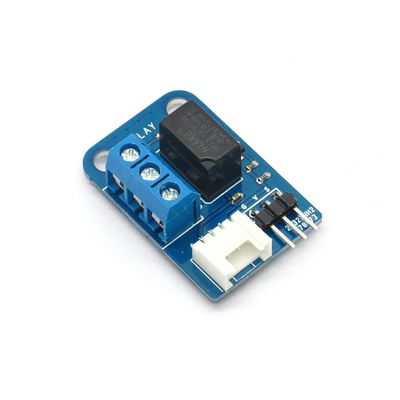5V Relay
Contents
Overview
What is an electronic brick? An electronic brick is an electronic module which can be assembled like Lego bricks simply by plugging in and pulling out. Compared to traditional universal boards and circuit modules assembled with various electronic components, electronic brick has standardized interfaces, plug and play, simplifying construction of prototype circuit on one’s own. There are many types of electronic bricks, and we provide more than twenty types with different functions including buttons, sensors, Bluetooth modules, etc, whose functions cover from sensor to motor drive, from Ethernet to wireless communication via Bluetooth, and so on. We will continue to add more types to meet the various needs of different projects.
Electronic brick of relay can be connected to digital I/O port, when the input of S port is low level, relay will be under ‘disconnect’state; when the input of S port is high level, relay will be under ‘connect’state. It can be connected in series to the LED lights, buzzer or even the loop of a small lamp so as to control the state of the switch.
Go shopping 5V Relay (IM120710007)
Features
1. Plug and play, easy to use. Compatible with the mainstream 2.54 interfaces and 4-Pin Grove interfaces in the market.

2. With use of M4 standard fixed holes, compatible with M4-standard kits such as Lego and Makeblock.

3. With protection circuit to prevent from burning the relay coil when disconnected; with isolation circuit to prevent damages to I / O port by relay switch current.

4. With LED status lamp to indicate whether it is currently connected or not.

5. Terminals with screws for easy wiring and removing

Specifications
| PCB size | 36.0mm X 24.0mm X 1.6mm |
| Working voltage | 5V DC |
| Operating voltage | 5V DC |
| Compatible interfaces | 2.54 3-pin interface and 4-pin Grove interface(1) |
Note 1: S for digital output port, V and G for voltage at the common collector and ground respectively
Electrical Characteristics
| Parameter | Min. | Typical | Max. | Unit |
| Working voltage | 4.5 | 5 | 5.5 | VDC |
| Digital input voltage(VCC=5V) | 0 | - | 5 | V |
| Working current(VCC=5V) | - | 34 | - | mA |
| Maximum Switch current | - | 2 | - | A |
| Maximum Switch AC | - | 120 | - | VAC |
| Maximum Switch DC | - | 24 | - | VDC |
Indicator
Status lamp
For NO and COM ports, when relay is connected, LED lamp will be ON; when relay is disconnected, LED lamp will be off.
Demo
Connect S port of electronic brick of relay to D2 port of Arduino board, then connect COM and NO ports of relay in series to loop of LED, and we will use the following program to make LED lamp flash at intervals of 1s.
int relay = 2;
void setup() {
// initialize the digital pin as an output.
pinMode(relay, OUTPUT);
}
void loop() {
digitalWrite(relay, HIGH); // turn the relay on(HIGH is the voltage level)
delay(1000); // wait for a second
digitalWrite(relay, LOW); // turn the relay on by making the voltage LOW
delay(1000); // wait for a second
}
Download
Schematic--File:sch_IM120710007.pdf
 Notice
Notice